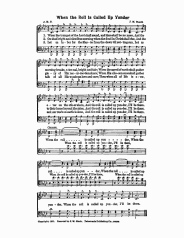If It Is In The Scale, It Probably Works.
When creating a run, it is essential that you have a good grasp of scales. Many classical pianists are well versed in scales, but do not know how or when to apply them. Many church pianists, even if they know how to apply them, stumble when it comes to scale passages. We should seek a balance between the two: The more you know about how to apply scales, the better you should be at playing them. Having a practical working knowledge of scales is the greatest benefit to improvisation; learn scales well, and nothing will be out of your grasp.
Using scales for runs in the evangelistic style are perhaps one of the most impressive musical elements one can produce. The steps involved are as follows:
- Determine where you are trying to put the run.
- Decide on a target note.
- Choose an appropriate rhythm for the run.
- Count how many notes will fit into the run.
- Adjust the starting note so that it is the first note of a chord.
- Make sure it sounds good!
Look at the song When The Roll Is Called Up Yonder. If you wish, you may print out the sample provided below, or you may reference your own hymn book. We will be looking at short runs first, usually lasting only one beat, which occurs in the melody. These small runs are a great introduction to the larger, sweeping runs you will learn later.

